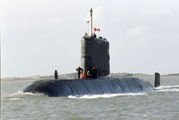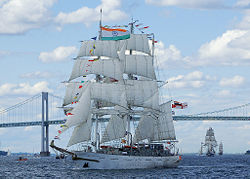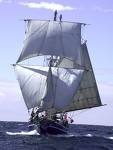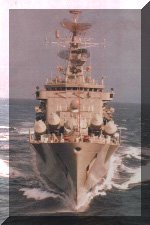Sailing began as a way to explore the world. While today's sailors still retain the bold spirit of explorers from centuries past, sailing is no longer a primary means of transportation and international trade or method of war. Since the 17th century, people have been setting sail for adventure and sport.
Most modern sailors sail because they love being on the water. Sailing is ranked as the 17th fastest-growing sport in the U.S., and it's estimated that more than 4 million Americans are recreational sailors [source: The Boating Channel]. The appeal of sailing is ageless: 40 percent of sailors are between the ages of 25 to 44, and roughly 17 percent are younger than age 17 [source: The Boating Channel].
So whether you're inspired by famous explorers such as Amerigo Vespucci or Vasco Da Gama, the winners of the America's Cup sailing races, or you just love the feel of wind in your hair, sailing is a sport to sate your adventurous side. Fair winds!
Types of Recreational Sailing
If you're looking for a little fun and some high-seas adventure, there are some popular types of recreational sailing that may suit you. If you're looking for something a little different, we have a few unconventional suggestions, too.
If you're a sailing novice, you might want to start out with small sailboats like dinghies, daysailers and small keelboats. They're easy to maneuver, are usually less than 25 feet in length. These can be sailed by an individual (solo sailing) or with one crewmember [source: U.S. Sailing]. Some sailors begin with small sailboats and continue adventuring this way even as they become experts. Dinghies are fun and lightweight -- they're used by college racing teams and in the Olympics, and they're perfect for weekend warriors.

Chris Jackson/Getty Images
A fleet of 50 Enterprise dinghies sails down the Thames past Chelsea Bridge and Battersea Power Station in London.
Some adventurers, though, take their sailing hobby to a whole new level and go cruising. Cruising isn't a just a hobby; it's a lifestyle. When you hear about someone who is sailing around the world, they're cruising. Sailors who choose cruising live on their sailboats and travel for extended periods of time. Their vessels range from basic keelboats to large, multi-hull cruising yachts. Most boats intended for cruising have many of the comforts of home below deck, and depending on their size, may include beds, bathrooms, kitchen facilities and even entertainment systems.
For those who want the adventure or relaxation of sailing without the work, boats can be chartered with skippers, and yachts can be chartered with crews. Two popular types of family-friendly chartered sailing adventures are sunset cruises and Caribbean sailing vacations. Sunset cruises are leisurely sailing experiences and are typically chartered by small groups looking to relax. If sailing in the Caribbean like the rich and famous sounds more like your style, boats (with or without hired crews) may be chartered through travel agencies. Some popular island destinations for Caribbean sailors include the Virgin Islands, Antigua, St. Barts, St. Martin and Grenada.
Basic Sailing Skills and Terms
The basics of sailing are easy to learn in a few classes, although it can take a lifetime to perfect them. Of the many skills and techniques to learn about sailing, there are five essentials: sail setting, boat balance, fore and aft trim, position of the centerboard, and course made good.

Ryan McVay/Allsport Concepts
The crew members of a racing yacht are sure to know the five basics of sailing.
- Sail setting: Sailboats can't be taken directly into the wind or they run the risk of stopping (when there's literally no wind in your sails). Depending on your point of sail -- the direction of your boat in relation to the direction of the wind -- different sail settings are needed. You can set your main sail by listening to it: Ease the sail out until it flaps along the luff, the part closest to the mast, and then pull it back in just until the flapping stops.
- Boat balance: When your boat begins to lean to one side, it's known as heeling. To overcome heeling and stay on course, it's important to stay aware of the wind (is it gusting?) and the position of your sails. Also keep aware of the weight you have onboard and how it's distributed. If your boat is leaning port side, you can counteract it by moving your weight (or the weight of the crew) to the opposite, or starboard, side.
- Fore and aft trim: A boat must also stay balanced from end-to-end. Generally, the front of a boat (bow) is raised slightly higher than the back (stern), and the distribution of body weight on board (you and your crew) is key to maintaining that balance. If you find your boat is dragging in the water (an example of what happens when the back of the boat is too low), move your weight closer to the middle or front of the boat. If the bow is submerging in the water, take a seat toward the back of the boat. A correctly balanced boat allows you to sail more quickly.
- Position of the centerboard: There is a delicate balance between your boat and the wind, and you can easily find yourself being pushed off course by it. The centerboard, a piece of wood, fiberglass or metal (depending on what your boat is made from), is a movable fin under the hull. By adjusting it in relation to your point of sail, you're able to correct any drift.
- Course made good: Getting from point A to point B isn't always a straight course, especially if the straight course takes you directly into the wind. Planning a route that gets you to your destination in the shortest possible time is called "course made good." This is generally accomplished through a maneuver called tacking, in which the boat is steered in a zigzag, upwind direction.
To find a sailing school in the United States, visit the American Sailing Association.
There are hundreds of knots but only a few basics that should be on your practice list:
- Bowline: A bowline knot is your standby. It creates a loop at the end of a top, is strong and easy to untie. If you know the old saying, the rabbit comes out of his hole, 'round the tree and back down into his hole, you already know the bowline. When in doubt, use this knot.
- Square knot: The square knot, or reef knot, is used to tie two ropes (lines) of the same size together. You may be familiar with it from Boy Scouts or Girl Scouts, first-aid class or from tying your shoelaces.
- Clove hitch: This loop is a quick way to temporarily moor a small boat to a ring, rail or post.
- Round turn and two half hitches: This knot is frequently used to secure a boat to the docking ring or post.
- Figure-of-eight: This stopper knot is used to prevent a rope from unraveling or slipping out of a ring or other device. This type of knot is essential in both sailing and rock climbing.
- Sheet bend: Need a longer rope? A sheet bend knot is a quick way to fasten two lines temporarily.
Sailing Safety and Regulations
To keep recreational sailing a fun and safe activity, there are some rules sailors are expected to follow. First, it's important to be honest about your skill level. Don't overextend yourself -- if you're a beginner or an old pro, going beyond your skill puts both you and others at risk. According to the U.S. Coast Guard, 70 percent of reported deaths at sea occur because the boat operator didn't have adequate (or any) boating instruction [source: U.S. Coast Guard].

Peter Mumford/Beken/Kos Picture Source via Getty Images
Sailors need to pay attention to the weather forecast so they don't get caught in a sudden squall. These yachts are competing in the J109 UK National Championships.Your skills will only take you so far -- you'll need wind in your sails to get you out on the water. Make sure to determine the wind speed and direction before you set out. Also check the forecast. It may be sunny as you make your preparations, but a change in the weather could result in a dangerous expedition.
Sailboat Racing As their sailing skills improve, many sailors enjoy testing their techniques, strategies and tactics in races. Races are organized by sailing clubs and schools around the world. There are two types of sailboat races: team racing (or fleet racing) where two to four boats compete together, and match racing, where two boats compete head to head.
One of the most famous two-boat races is the America's Cup, in which the best sailors, engineers and boat builders get to show off their skills. The rules -- known as the Racing Rules of Sailing -- are established by the International Sailing Federation (ISAF) and are published every four years. Visit the ISAF to download a copy of the Racing Rules of Sailing.With skill level and wind direction determined, you'll also want to inspect your boat, gear and tools to ensure they're all in good condition, and note if you have everything you need onboard before setting out. Federal law requires you to carry safety equipment onboard. You and your crew should wear life jackets and all know how to use the boat's safety equipment. Be sure to know how to make a distress call for immediate assistance -- the time you find yourself in trouble is not the time to figure how to call for help.
It's also smart to have a plan. On your adventure you'll likely be out of sight of land, and if you have an emergency, it might be difficult for help to find you. Put together a float plan and leave a copy with a friend or local marina before you set sail. At the least, your plan should include:
- A description of your boat
- The name of your boat operator and the names of all people onboard
- What type of safety and survival equipment you have with you (food, flares, paddles, marine radios, etc.)
- Your destination, arrival and departure times
Skill, wind, inspection and a plan -- check. Once you've launched your boat, be alert and aware of your surroundings. By simply maintaining a safe speed and looking around you, you're less likely to collide with other boats or objects (the top two causes of accidents [source: U.S. Coast Guard]). And leave the alcohol on shore: Drinking and operating equipment is just as dangerous at sea as it is on the roads. Violators with a blood alcohol content of .08 percent or higher may be subject to civil and criminal penalties, one year imprisonment or both. [source: U.S. Coast Guard]. Alcohol use is a leading factor in fatal boating accidents -- nearly 20 percent of reported fatalities [source: U.S. Coast Guard].
For a comprehensive list of rules and regulations, visit the U.S. Coast Guard's Navigation Center.
If you're smart and follow basic sailing regulations, you should be able to stay safe on your expedition. But sailors are a superstitious bunch and have many nautical myths:
- Whistling: It's a universal sailing superstition that whistling onboard will surely whip up the winds, thus the saying "whistling up a storm."
- Earrings: Some sailors believe they cannot drown if they wear earrings.
- Lefties: It's said sailors would never step on or off a boat leading with the left foot, fearing bad luck. This is a type of sinistrophobia, the fear of things on the left side of the body, and of south-paws.
- Animals: Superstitions surrounding animals abound. Black cats are good omens, as are dolphins. But watch out for sharks; they're rumored to spell doom.
- The Flying Dutchman: The Flying Dutchman is a ghost ship, and as legend goes, its appearance signals imminent danger or death to those who see it.


































 INS Sindhuvir sailing in the high seas
INS Sindhuvir sailing in the high seas








